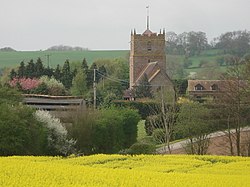Middleton on the Hill: Difference between revisions
Created page with '{{Infobox town |name=Middleton on the Hill |county=Herefordshire |picture=Middleton on the Hill Church - geograph.org.uk - 454690.jpg |os grid ref=SO545645 |latitude=52.277 |lo…' |
m moved Middleton-on-the-Hill to Middleton on the Hill |
(No difference)
| |
Revision as of 22:46, 7 November 2012
| Middleton on the Hill | |
| Herefordshire | |
|---|---|

| |
| Location | |
| Grid reference: | SO545645 |
| Location: | 52°16’37"N, 2°40’23"W |
| Data | |
| Post town: | Hereford |
| Postcode: | HR6, SY8 |
| Dialling code: | 01568 |
| Local Government | |
| Council: | Herefordshire |
Middleton on the Hill is a village in northeast Herefordshire. It is within the parish of Leominster and is near the border with Worcestershire. Middleton-on-the-Hill lies a few miles to the east of the A49 between Ludlow and Leominster. The village is now primarily a home for commuters. Its population in 1861 was 445 and in 1871 it was 382. The population was 244 at the 2001 census.
Middleton on the Hill is one of the Thankful Villages; those villages which suffered no fatalities during the Great War of 1914 to 1918. It is indeed Twice-Thankful, as all the Middleton men returned after the Second World War as well; one of very few villages in the land twice blessed in this way.
Name
Most villages called “Middleton” derive their name from ‘’middel tun’’ (“middle village”) but that is not the case here. Middleton on the Hill is recorded in the Domesday Book of 1086 as Miceltune
The name ‘’Miceltune’’ is the Old English ‘’micel tun’’ meaning “Big estate / village”.[1]
History
In the Domesday Book, ‘’Miceltune’’ is recorded as part of the lands belonging to Leominster.[2] It states also that in the time of King Edward, which is to say before the Norman Conquest, it had belonged to Durand, the Sheriff. The estate was rated as worth ten shillings.
Buildings
Saint Mary's church is in the Norman and Early English styles and has a large tower which contained three bells. This older church had outlived the chapel which was demolished in 1800. In the churchyard is a war memorial that unusually is shaped like a lantern. The inscription reads:
A thank offering to Almighty God
"At evening time it shall be light "
for the safe return of all the men from this parish
who fought in the Great War 1914 - 1918
and 1939 - 1945[3]
In 1874 a school was erected at a cost of £210 that could cater for 42 children. A building stood here was called Moor Abbey and was the remains of a much older building. This building would have had a moat.[4]
Church of St Thomas
A short distance away, about 3 miles (5 km) south east of Middleton and near Tenbury Wells[5] is the church of Saint Thomas which was founded by the Reverend Sir Frederick Arthur Gore Ouseley, Baronet, MA at an outlay of nearly £30,000.[4] Frederick Ouseley was the musical prodigy son of Sir Gore Ouseley, the diplomat who served in Persia, Russia and India.
The church is a magnificent structure of stone, in the Middle Pointed style of architecture, and was consecrated on the 29 September 1856. There is beautiful stained glass in the east and west windows in particular, which represents figures of angels and the Crucifixion.
The font is placed in a complete baptistery well of water, and there were only two of its kind when it was installed.
The organ, a remarkable instrument that has 64 stops and four manuals, with many other novel and effective features, was installed under the direction of the Rev. Sir Frederick A. Gore Ouseley, Bart., M.A., Mus. Doc., Professor of Music in the University of Oxford, and precentor of Hereford Cathedral.
Outside links
| ("Wikimedia Commons" has material about Middleton on the Hill) |
References
- ↑ A.D. Mills, Dictionary of English Place-Names, 2001
- ↑ Domesday Book: A Complete Translation. London: Penguin, 2003. ISBN 0-14-143994-7 p.497 and 1576
- ↑ Middleon site on demon accessed 8 November 2007
- ↑ 4.0 4.1 Extract from Littlebury's Directory and Gazetteer of Herefordshire, 1876-7 in Genuki accessed 7 November 2007
- ↑ Tenbury Wells and the Teme Valley, 2007, p10
